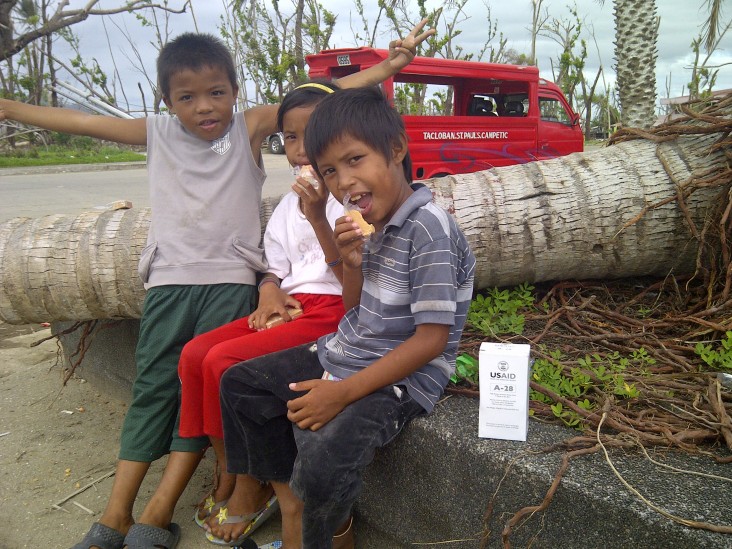
May 2014—A once-in-a-generation typhoon made landfall in the Philippines on Nov. 8, 2013, leaving a trail of devastation. Category 5 typhoon Haiyan, known locally as Yolanda, affected 14 million people, or 17 percent of the population. Yolanda killed 6,000 people, displaced 4.1 million others and caused billions of dollars in damages to local infrastructure and livelihoods.
Three days after the storm, the U.N. World Food Program (WFP) issued an appeal for emergency food assistance targeting 2.5 million people identified as most vulnerable in terms of food security. Many living on the islands of Leyte, Cebu and Visayas who relied heavily on fishing and agriculture for food had their fish stocks decimated and crops destroyed by Yolanda’s trail of destruction.
USAID was the first international agency to meet the call, authorizing a contribution of $10 million on the same day as the WFP appeal. USAID designed an innovative approach that combined traditional food aid with cash-based models.
Within three weeks of the storm’s landfall, USAID provided WFP and the Government of the Philippines with the tools to provide lifesaving assistance to the nearly 3 million people needing food. The approach combined the flexibility of cash-based assistance—which allowed for the immediate purchase of local rice as well as cash transfers in areas with properly functioning markets—with U.S. in-kind food.
“I’m really grateful for the food that saved our lives after Yolanda hit,” said Alberto*, a local fisherman in Guiuan whose family was among the many who lost homes and livelihoods.
USAID’s cash assistance enabled WFP to immediately purchase 2,400 tons of rice directly from the Government of the Philippines and to airlift from Dubai 40 tons of high-energy biscuits, which are nutrient-dense meal supplements that do not require cooking. Both commodities were part of the first family food packs distributed on Nov. 13 by the Department of Social Welfare and Development.
In less affected areas with functioning agricultural markets, USAID provided unconditional cash transfers for the purchase of basic food items before initial harvests came in.
"Our rice harvest will be less than half its normal size,” said Silvia, a rice farmer in Roxas. “We really appreciate receiving both rice, which is not available locally, and the money that has allowed us to buy other food from the shops."
USAID also provided more than $2 million in U.S. in-kind food as part of its initial contribution to WFP’s emergency operation. Two days after the typhoon struck, USAID authorized an airlift of 55 tons of nutrient-dense, meal-replacement food bars and paste as well as the immediate shipment of 1,020 tons of rice from its prepositioning warehouse in Colombo, Sri Lanka. The emergency food products arrived on Nov. 13, followed by the rice on Dec. 3.
As the humanitarian response shifted from emergency relief to early recovery in mid-December, USAID announced its second contribution of $10 million for an additional purchase of 5,000 tons of U.S.-purchased rice and $3.7 million for food- and voucher-for-assets activities. Through these activities, agricultural assets such as irrigation canals and farm-to-market feeder roads are rehabilitated in exchange for either food or vouchers. The rice arrived on Feb. 20, 2014, in time to support food-for-assets activities and targeted unconditional distributions to vulnerable groups such as the elderly and disabled.
The situation in the Philippines highlights the importance of putting forth a multifaceted disaster response. By having the ability to respond both with food purchased locally and from the United States, USAID was able to respond quickly and efficiently to meet the most urgent food-related needs of one of the worst storms in recorded history.
*Last names not available.







Comment
Make a general inquiry or suggest an improvement.